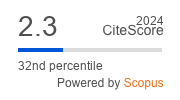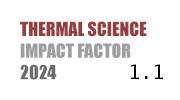ABSTRACT
Methanol is a renewable and sustainable energy source with potential to overcome energy scarcity, global warming, and environmental pollution caused by the overdependence on fossil energy. However, its application in engines faces challenges, particularly the cold start issues. Turbulent Jet Ignition (TJI) presents a promising solution due to its advantage of multipoint ignition, and thereby a comprehensive study of TJI can contribute to guide the design and optimization of methanol engines. This work establishes an experimental system, employing the high-speed schlieren imaging technique to observe the propagation of methanol jet flames, and investigates the influence on the combustion characteristics of various operating parameters, such as the initial temperature and pressure and the intervals between the two ignitions. The results indicate that the propagation of the jet flame accelerates with the equivalence ratio increasing from 0.8 to 1.2. When the equivalence ratio is 1.0 and 1.2, the higher initial pressure results in slower development of the jet flame. Additionally, a short ignition interval leads to sluggish jet flame development and prolonged combustion duration, while an excessively prolonged ignition interval makes it impossible to generate effective jet flame. This research provides valuable insights for optimizing the jet ignition operation and enhancing the efficiency of methanol engines.
KEYWORDS
PAPER SUBMITTED: 2025-03-25
PAPER REVISED: 2025-05-20
PAPER ACCEPTED: 2025-05-29
PUBLISHED ONLINE: 2025-07-05
- Mukherji, A., et al., SYNTHESIS REPORT OF THE IPCC SIXTH ASSESSMENT REPORT (AR6)
- Verhelst, S., et al., Methanol As A Fuel For Internal Combustion Engines, Progress in Energy and Combustion Science, 70 (2019), pp. 43-88
- Çelebi, Y., Aydın, H., An Overview On The Light Alcohol Fuels In Diesel Engines, Fuel, 236 (2019), pp. 890-911
- Turner, J.W.G., et al., Alcohol Fuels For Spark-Ignition Engines: Performance, Efficiency And Emission Effects At Mid To High Blend Rates For Binary Mixtures And Pure Components, Proceedings of the Institution of Mechanical Engineers, Part D: Journal of Automobile Engineering, 232 (2018), 1, pp. 36-56
- Huang, Q., et al., On The Use Of Artificial Neural Networks To Model The Performance And Emissions Of A Heavy-Duty Natural Gas Spark Ignition Engine, International Journal of Engine Research, 23 (2022), 11, pp. 1879-1898
- Surisetty, V.R., et al., Alcohols As Alternative Fuels: An Overview, Applied Catalysis A: General, 404 (2011), 1, pp. 1-11 12
- Zhen, X., Wang, Y., An Overview Of Methanol As An Internal Combustion Engine Fuel, Renewable and Sustainable Energy Reviews, 52 (2015), pp. 477-493
- Ainsalo, A., et al., OPTICAL INVESTIGATION OF SPRAY CHARACTERISTICS FOR LIGHT FUEL OIL, KEROSENE, HEXANE, METHANOL, AND PROPANE, Atomiz Spr, 29 (2019), 6, pp. 521-544
- Matamis, A., et al., Optical Characterization Of Methanol Compression-Ignition Combustion In A Heavy-Duty Engine, Proceedings of the Combustion Institute, 38 (2021), 4, pp. 5509-5517
- Badawy, T., et al., Macroscopic Spray Characteristics Of Iso-Octane, Ethanol, Gasoline And Methanol From A Multi-Hole Injector Under Flash Boiling Conditions, Fuel, 307 (2022), pp. 121820
- Zeng, W., et al., Characterization of Methanol and Ethanol Sprays from Different DI Injectors by Using Mie-scattering and Laser Induced Fluorescence at Potential Engine Cold-start Conditions, Proceedings, April 12, 2010, pp. 2010-01-0602
- Chen, Z., et al., Effect Of Fuel Temperature On The Methanol Spray And Nozzle Internal Flow, Applied Thermal Engineering, 114 (2017), pp. 673-684
- Wu, F., et al., Experimental Study Of Methanol Atomization And Spray Explosion Characteristic Under Negative Pressure, Process Safety and Environmental Protection, 161 (2022), pp. 162-174
- Li, G., et al., Analysis Of Micro-Mixing And Chemical Kinetic Effects Of Ultra-Lean Methane-Air Mixture Ignited By Turbulent Jets, Fuel, 341 (2023), pp. 127604
- Abramovich, L., et al., CARBURETOR TYPE INTERNAL COMBUSTION ENGINE WITH PRECHAMBER, Proceedings, 2017
- Long, W., et al., Effects Of Dual-Direct Injection Parameters On Performance Of Fuel Jet Controlled Compression Ignition Mode On A High-Speed Light Duty Engine, Fuel, 235 (2019), pp. 658-669
- Li, B., et al., Multiple-Objective Optimization Of Jet Controlled Compression Ignition (JCCI) Mode With Dual-Direct Injection In A High-Speed Light-Duty Engine, Fuel, 333 (2023), pp. 126327
- Tang, Q., et al., Optical Diagnostics On The Pre-Chamber Jet And Main Chamber Ignition In The Active Pre-Chamber Combustion (PCC), Combustion and Flame, 228 (2021), pp. 218-235
- Tang, Q., et al., Study On The Effects Of Narrow-Throat Pre-Chamber Geometry On The Pre-Chamber Jet Velocity Using Dual Formaldehyde PLIF Imaging, Combustion and Flame, 240 (2022), pp. 111987
- García-Oliver, J.M., et al., An Experimental And One-Dimensional Modeling Analysis Of Turbulent Gas Ejection In Pre-Chamber Engines, Fuel, 299 (2021), pp. 120861
- Liu, Z., et al., Enhanced Combustion Of Ammonia Engine Based On Novel Air-Assisted Pre-Chamber Turbulent Jet Ignition, Energy Conversion and Management, 276 (2023), pp. 116526
- Liu, Z., et al., Experimental Investigation On The Performance Of Pure Ammonia Engine Based On Reactivity Controlled Turbulent Jet Ignition, Fuel, 335 (2023), pp. 127116
- Liu, Z., et al., Reactivity Controlled Turbulent Jet Ignition (RCTJI) For Ammonia Engine, International Journal of Hydrogen Energy, 48 (2023), 33, pp. 12519-12522
- Xu, C., et al., Laminar Flame Characteristcs Of Ethanol-Air Mixture: Experimental And Simulation Study, Therm sci, 22 (2018), 3, pp. 1453-1444 [25] Oppong, F., et al., An Experimental And Numerical Study Of Propyl Acetate Laminar Combustion Characteristics, Combustion and Flame, 268 (2024), pp. 113651
- Wang, Q., et al., Laminar Burning Velocity And Explosion Characteristics Of A Lignocellulose-Derived Bio-Jet Fuel At Elevated Pressures And Temperatures, Fuel, 383 (2025), pp. 133834

